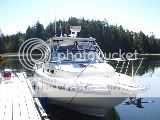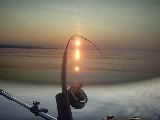Sushihunter
Active Member
Fishing charter eyes beacons
Response to tragedy off Island
By Katie DeRosa, Times Colonist August 12, 2010 1:06 AM
Owners of a fishing charter company in Winter Harbour say they will likely outfit their fleet with emergency locator beacons after four men died during a fishing excursion last week.
"They're not required for every boat but for us, we will definitely have them," said Rob Knutson, who runs the family-owned Qualicum Rivers Fishing Charters and Lodge on the northwest coast of the Island.
He was responding to calls that GPS locators should be mandatory for small vessels, made this week by the family of Port Alberni fishing guide Kevin Sturgess, believed drowned along with the three guests on the boat.
"We'll look into it for sure," Knutson said.
The Qualicum River 9 set out Aug. 2 for a fishing trip in Brooks Bay, but capsized amid gale-force winds and three-metre waves.
Heavy fog hid the grey vessel from search and rescue crews until Saturday. After life-jackets were discovered with the vessel, the search was called off. The coast guard said the search could have taken just a few hours if the vessel had an emergency position-indicating radio beacon.
The devices are required by Transport Canada on vessels larger than eight metres, carrying more than six passengers. But the agency recommends them for all vessels.
Transport Canada will do a "risk audit" on the company's entire fleet, beginning next week, and the Transportation Safety Board is also investigating.
Knutson said the six-metre aluminum vessel was in top working order, with new steering and a new motor installed in June as part of its annual inspection.
The lodge is responsible for inspecting its fleet annually under Transport Canada's Small Vessel Inspection Monitoring Program, which applies to vessels under 15 gross tons that carry fewer then 12 passengers.
Knutson said the lodge sends a report and photos of each vessel to prove they meet safety standards.
WorkSafe B.C. is also investigating the incident, which spokesman Scott McCloy said will likely focus on why the men weren't required by the lodge to wear life-jackets while on the water and why the vessel didn't have a GPS locator.
On the boat with 36-year-old Sturgess were three Americans -- Peter Idlewine, 53, of Brush Prairie, Wash., Gary Evans, 55, of Vancouver, Wash., and Tony Evans, 52, of Portland, Ore.
kderosa@tc.canwest.com
© Copyright (c) The Victoria Times Colonist
Read more: http://www.timescolonist.com/news/Fishing+charter+eyes+beacons/3389350/story.html#ixzz0wOQkthuz
Jim's Fishing Charters
www.JimsFishing.com
http://www.youtube.com/user/Sushihunter250

Response to tragedy off Island
By Katie DeRosa, Times Colonist August 12, 2010 1:06 AM
Owners of a fishing charter company in Winter Harbour say they will likely outfit their fleet with emergency locator beacons after four men died during a fishing excursion last week.
"They're not required for every boat but for us, we will definitely have them," said Rob Knutson, who runs the family-owned Qualicum Rivers Fishing Charters and Lodge on the northwest coast of the Island.
He was responding to calls that GPS locators should be mandatory for small vessels, made this week by the family of Port Alberni fishing guide Kevin Sturgess, believed drowned along with the three guests on the boat.
"We'll look into it for sure," Knutson said.
The Qualicum River 9 set out Aug. 2 for a fishing trip in Brooks Bay, but capsized amid gale-force winds and three-metre waves.
Heavy fog hid the grey vessel from search and rescue crews until Saturday. After life-jackets were discovered with the vessel, the search was called off. The coast guard said the search could have taken just a few hours if the vessel had an emergency position-indicating radio beacon.
The devices are required by Transport Canada on vessels larger than eight metres, carrying more than six passengers. But the agency recommends them for all vessels.
Transport Canada will do a "risk audit" on the company's entire fleet, beginning next week, and the Transportation Safety Board is also investigating.
Knutson said the six-metre aluminum vessel was in top working order, with new steering and a new motor installed in June as part of its annual inspection.
The lodge is responsible for inspecting its fleet annually under Transport Canada's Small Vessel Inspection Monitoring Program, which applies to vessels under 15 gross tons that carry fewer then 12 passengers.
Knutson said the lodge sends a report and photos of each vessel to prove they meet safety standards.
WorkSafe B.C. is also investigating the incident, which spokesman Scott McCloy said will likely focus on why the men weren't required by the lodge to wear life-jackets while on the water and why the vessel didn't have a GPS locator.
On the boat with 36-year-old Sturgess were three Americans -- Peter Idlewine, 53, of Brush Prairie, Wash., Gary Evans, 55, of Vancouver, Wash., and Tony Evans, 52, of Portland, Ore.
kderosa@tc.canwest.com
© Copyright (c) The Victoria Times Colonist
Read more: http://www.timescolonist.com/news/Fishing+charter+eyes+beacons/3389350/story.html#ixzz0wOQkthuz
Jim's Fishing Charters
www.JimsFishing.com
http://www.youtube.com/user/Sushihunter250




